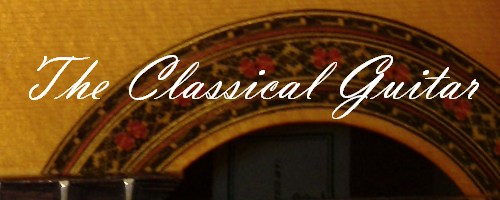The Classical Guitar
The Classical Guitar
 The classical guitar is one of several types of guitars within the chordophone class of musical instruments. All guitar types are in the stringed and fretted instrument category. The classical guitar has a close cousin, the flamenco guitar, which is quite similar. To most laypersons it is the same as a classical guitar. The main differences between the classical guitar and the flamenco guitar lay in their construction. The thickness of the wood and to a degree the selection and type of tone woods used in their construction are two key differences between them.
The classical guitar is one of several types of guitars within the chordophone class of musical instruments. All guitar types are in the stringed and fretted instrument category. The classical guitar has a close cousin, the flamenco guitar, which is quite similar. To most laypersons it is the same as a classical guitar. The main differences between the classical guitar and the flamenco guitar lay in their construction. The thickness of the wood and to a degree the selection and type of tone woods used in their construction are two key differences between them.
From a performance perspective, the main physical characteristic which separates and distinguishes them is in the style of playing where the flamenco guitar is played using more percussive methods of sound production and considerably more strumming techniques. The widely recognized rasqueado style of strumming is a good example of this. For our purposes and for meeting the intent for the instrument articles currently being written, we are considering both of them to be similar enough that this article will refer to both the classical and the flamenco guitars.
Both types of guitars offer excellent sonic beauty, class and sophistication as stringed instruments. It is difficult to describe the capabilities of the classical guitar in such a short presentation as there are a wide variety of performance techniques and articulations available to the performer who uses this instrument. Likewise, the composer is able to utilize these articulations when composing music for the classical guitar to attain different emotional responses within the audience’s listening experience.
The classical guitar is an instrument of visual and sonic beauty. Master luthiers will spend months and sometimes over a year to complete one instrument. The art and craft of building classical guitars is nothing short of amazing. The end results are well worth the wait while the guitar is being built. Upon receiving your newly built instrument, The ensuing rush of enthusiasm and creativity overcomes most guitarists and yet it is highly welcomed.
In this modern era of music, one man, Andres Segovia, was highly instrumental in causing the world to look closer at the classical guitar as a serious orchestral instrument. As a result of his constant promotion, performance, teaching, music adaptation and arranging and his shear persistence Segovia almost single handedly brought the classical guitar into the orchestra as well as profoundly influencing generations of performers at the same time. His influence continues to be felt throughout the classical guitar repertoire and marketplace.
A large body of music is available to performers of the classical guitar. New compositions written specifically for the classical guitar, transcriptions of lute music, piano music and other music written for different instruments and arranged for classical guitar has made this large repertoire possible. When attempting to choose one video as an example (in the video format for this article) I soon realized how difficult a task this would become.
Having listened and watched many video taped performances, I was seeking a video which was a fair and respectable representation of the classical guitar, its capabilities and sonic possibilities. The results of my search led me to select a video produced during the “Virtuosos of Guitar 2008” festival, which was held in Moscow of that same year. This particular performance is by Aniello Desiderio playing the variations of Paganini’s “Carnival of Venice” composed by Francisco Tarrega, a well known composer and transcriber of music to those familiar with the classical guitar repertoire. I chose the following video to demonstrate the incredible variety of possibilities the classical guitar has to offer in terms of technique, tone color and performance difficulty.
I wish to extend my gratitude and thankfulness to Aniello Desiderio* for his virtuosic performance as well as to Franscisco Tarrega for his Variations on the theme. Also, to YouTube for providing hosting for the video as well as access and use under their embed policies for non-commercial and educational use.
The Classical Guitar



